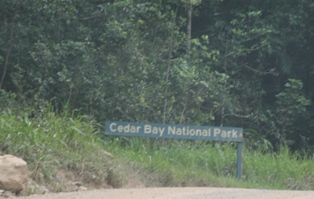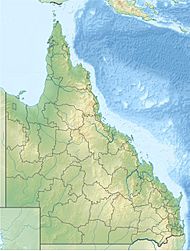Ngalba Bulal National Park facts for kids
Quick facts for kids Ngalba Bulal National ParkQueensland |
|
|---|---|
|
IUCN Category II (National Park)
|
|

Ngalba Bulal National Park
|
|
| Nearest town or city | Cooktown |
| Established | 2011 |
| Managing authorities | Queensland Parks and Wildlife Service |
| Website | Ngalba Bulal National Park |
| See also | Protected areas of Queensland |
Ngalba Bulal is a national park in the Shire of Cook, Queensland, Australia. In 2015, Cedar Bay National Park became the Mangkalba (Cedar Bay) section of the Ngalba Bulal National Park.
Contents
Geography
The park is 1,522 km (946 mi) northwest of Brisbane, 40 km (25 mi) south of Cooktown and accessible only by boat or foot. The park is one of the Wet Tropics World Heritage Area series of national parks, and is a gazetted World Heritage Site. It is also known as Mangkal-Mangkalba in the dialect of the local Aboriginal population, the Eastern Kuku Yalanji.
History
The Cedar Bay area was developed in the 1870s for tin mining, and the remains of the tin work can still be seen in the area of Black Snake Rocks.
Cedar Bay gained a degree of notoriety in the 1970s when the Bjelke-Petersen government destroyed a hippie commune that was present. At the Cedar Bay inquiry, police were accused of burning huts, smashing personal belongings, destroying clothing, and chopping down fruit plantations. Police, in their defence, tendered evidence of squalid living conditions and described the commune’s inhabitants as “filthy, criminal hippies”.
In 2007, the Cedar Bay National Park was part of the 2,000 square kilometres (770 sq mi) of land handed over to Cape York's Aboriginal population by the Queensland government. The handover came as a result of a 1994 Native Title claim.
Cedar Bay National Park was known as Mount Finnigan National Park before being enlarged.
Activities
The park contains some of the northernmost tropical rainforests in Australia. Birdwatching is a popular activity with the most common birds including cassowaries, yellow-breasted sunbirds, double-eyed fig-parrots, mangrove kingfishers, beach stone-curlews and pied imperial-pigeons. Bush camping is permitted in the park, however fishing and collecting are prohibited. The sole walking track in the park was a former donkey track used by tin miners. It is inaccessible to all but fit walkers.
See also
 In Spanish: Parque nacional Bahía Cedro para niños
In Spanish: Parque nacional Bahía Cedro para niños


